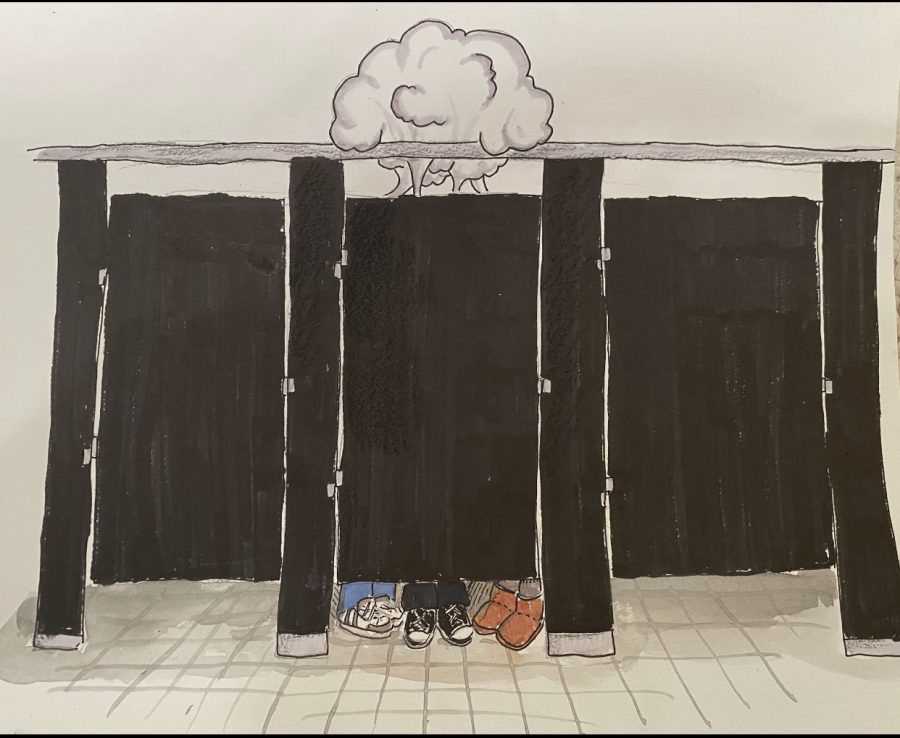Clearing the smoke
The Lane administration’s approach to vaping needs some new perspective
Illustration by Charlotte Price
Recently, anyone walking through Lane’s hallways will see reminders of the administration’s surge in vigilance against teen vaping. Posters taped to the walls in the hallway, and to stalls in the bathrooms, remind students that vaping is bad for you and that you will face consequences if caught.
And yet people are still doing it. Just more discreetly, so as not to be discovered during bathroom sweeps. Many people are still doing it, not because they don’t know that vaping and nicotine have negative impacts on their bodies, or because they aren’t afraid of getting in trouble, but because they need to and it’s so difficult to stop.
During school, for those addicted or dependent, the need to vape can be made even worse. One junior at Lane, who asked to remain anonymous, quit for a year, but relapsed on the first day of this school year during his second period class in the locker room.
“[The class] was rough because it was not a good vibe in there. Everybody was smoking and I was too,” said the Lane junior.
Another junior, who attends Amundsen and who has been trying to quit, says that being in school makes it very difficult for her.
“I get really anxious at school, and when I get anxious, I need it most. So, withdrawal symptoms are times ten at school. I’ll be very angry and irritated and won’t want to talk to anybody,” said the Amundsen junior, who also asked to remain anonymous.
A 2019 article from the Annals of Clinical Psychiatry journals finds that there are many factors that might contribute to someone starting to vape, such as stress, anxiety, and depression, but also the subtle social pressure.
“I feel like there is pressure, but it’s not a direct pressure. Almost everyone has it. You walk in the bathroom, at least one person will have it. It’s just like, when you’re around it all the time, you kind of want to try,” said the Amundsen junior.
Research conducted for an article in the American Journal of Preventive Medicine has proven this phenomenon as well, demonstrating that just being around other students vaping at school makes people more likely to start.
Considering this, along with the negative health impacts, such as the risk of cardiovascular disease, lung cancer and increased likelihood of developing mental illness, and the fact that learning is disrupted when students are compelled to leave class because of nicotine cravings, the administration’s desire to combat in-school vaping is important.
However, the current approach to addressing this issue has been relatively ineffective and reinforces the clear disconnect between administration and students on the subject.
On the one hand, interviews with administration have demonstrated that they do care, want to help and are here to support students.
“We are trying to build a net of adults in the building who are trying to look out for students in the best way that we can,” said Dean Dom Martin in reference to the Culture and Climate Team’s goals in addressing vaping. He also says that when he talks to students after they have been caught, he discusses with them not only the consequences of their actions, but also tries to get to the root of why they feel the need to vape in the first place. If they open up and reveal that they are stressed, anxious, or depressed, he will direct them towards the social workers.
“If I were to talk to them it would be about how it affects them mentally, in terms of their mood or other reasons why they’re vaping. If they’re vaping because they’re anxious then let’s talk about better ways to cope,” said social worker Ms. Mclaughin-Kantowicz, who is also a member of the Culture and Climate Team.
Yet to students, this desire to help, this compassion and understanding, is largely unheard of.
Instead, the posters that have been put up and the patrols to catch kids in the act, give an impression of rigidness, a lack of awareness on why people would start vaping in the first place, and makes students feel it is not safe to have a discussion on the subject with any adult in the building.
And this is where that disconnect is created. To many students it appears as if that the administration is treating vaping as an ‘out of sight, out of mind’ issue, which ignores the fact that if someone is vaping in school to begin with, they have likely developed a dependency or even an addiction, if they need it to be on them all day.
This means that vaping can not only be addressed by patrols and posters; it requires a significant shift in the approach that actually targets the roots of the issue. By not making it clear to students that the school is aware of the mental health influences that impact the choice to vape, by not expressing a desire to create a safe space for students to talk to adults about their nicotine dependence or addiction, the school has created a situation in which no one can win. Because why would anyone want to listen to people who do not seem to understand them or their peers? Why would students take the administration’s message to heart when there is a serious lack of trust?

The Champion’s Editorial Board believes that if the administration truly wants to make a dent in teen vaping, they need to actually listen to what students have to say on the subject, they need to communicate that they want the best for students and actualize that belief by informing students of the resources available to them in conjunction with education on the negative health impacts.
We recognize that it is a very difficult issue to address, and that attempting to gain student perspectives, insight, and trust will also be very difficult, but it is necessary. Already students are told that vaping is shameful, and are condescended to by adults for partaking when warnings of the negative health impacts are ubiquitous. But because of the previously discussed reasons for starting, this attitude only causes them to stay quiet and then a lack of conversation is normalized.
“It’s not really cool to go tell someone about your vaping. I don’t think anyone is really proud of it,” said the Lane junior.
This is part of the problem, and a barrier that will need to be overcome when establishing that it is OK to talk about it, and that students are not alone, that they are in fact, seen. It is important to note that admitting you vape on school grounds could lead to consequences; however, if a student decides to talk to a school counselor or social worker, admitting that the need to vape is making it difficult to be in class is a safer way to broach the subject.
If posters are the most effective form of widespread communication to begin implementing the message that admin is aware and willing to provide more holistic help, have them not just reference the consequences of in-school vaping, have them include techniques for those who might want to quit, have them include a list of resources and coping strategies that might tackle the reasons why they started vaping. When giving presentations on the harmful effects of vaping, also discuss the causes, and better alternatives for coping with stress and mental illness or resisting the subtle social pressure.
Whatever route is taken, it is essential that bridges are built across the chasm of misunderstanding between administration and students, because too much is being lost in translation and not enough is getting done.
Staff editorials represent the majority view of The Lane Tech Champion’s Editorial Board.
Thank you!! We met our goal for the 2023-24 school year! Your contributions covered our annual website hosting costs, which are no longer covered by our district/school. Student journalists at Lane Tech use this archive to research past coverage of various topics and link to past stories to offer readers additional context for current stories. Thank you for supporting the award-winning reporting and writing of journalism students at Lane Tech College Prep!
Background information on why the school district no longer allows our school to cover web hosting costs:
https://lanetechchampion.org/12583/uncategorized/special-coverage-impact-of-soppa-on-cps-students-teachers/
https://lanetechchampion.org/11702/opinion/staff-editorial-cpss-soppa-policy-is-choking-students-learning-and-the-champion/







